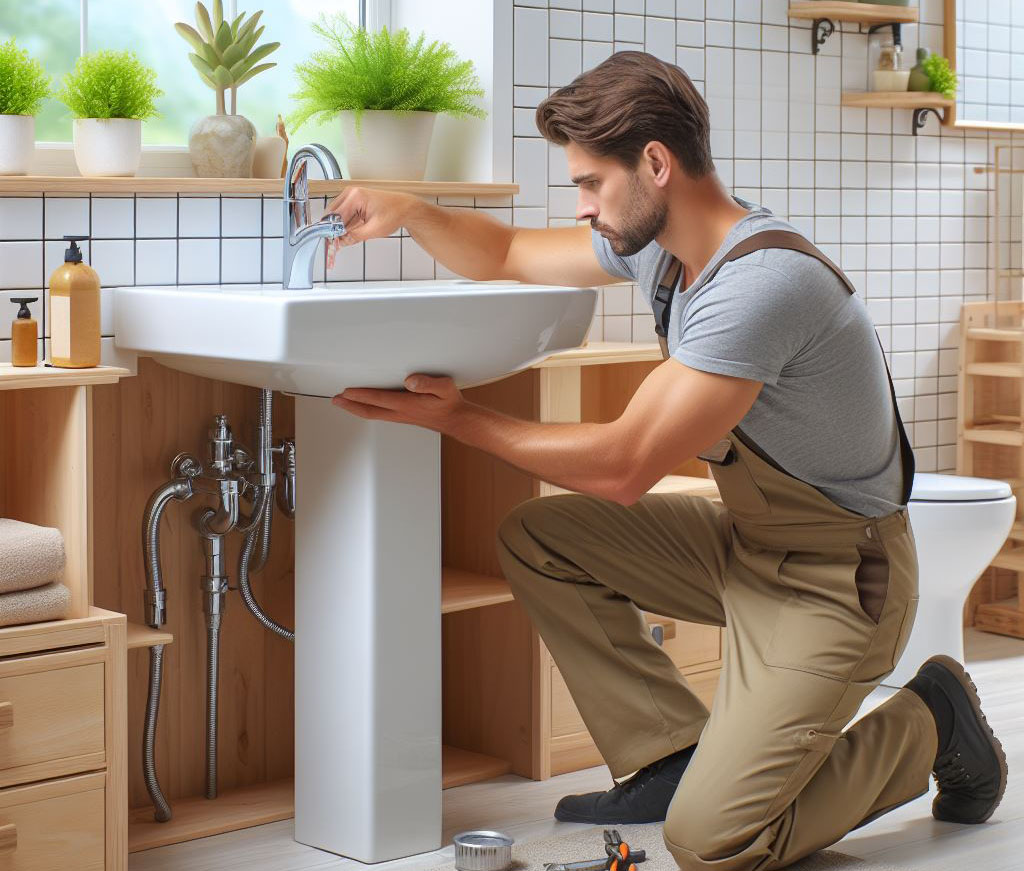Embarking on the installation of a pedestal sink unveils an opportunity to blend functionality with aesthetic appeal in your bathroom. The choice of a pedestal sink is a nod towards maximizing space without sacrificing style, making it an excellent option for both renovations and new constructions. This task, seemingly reserved for the experienced professional, is surprisingly accessible to the DIY enthusiast. It embodies the spirit of home improvement, combining simplicity with a rewarding finish, making it an ideal project for home handymen and self-employed construction aficionados alike.

Choosing the Right Pedestal Sink
The journey to selecting the ideal pedestal sink is one of careful consideration, blending practicality with personal taste. Here’s a nuanced approach to making that choice:
- Size: The cornerstone of a successful installation is ensuring the sink dimensions harmonize with your bathroom space. Accuracy in measurement is paramount to avoid compromising functionality and movement within the room.
- Style: The pedestal sink serves as a focal point, its style echoing the overall theme of your bathroom. Whether you lean towards period elegance or contemporary sleekness, the sink should complement the bathroom’s existing fixtures and ambiance.
- Material: Durability meets design in the choice of material for your pedestal sink. From the robustness of vitreous china to the refined finish of porcelain, select a material that promises longevity while enhancing the room’s aesthetic.
Pro Tip: Faucet compatibility should not be an afterthought. Ensure the sink selection accommodates your faucet choice, both functionally and stylistically, to avoid any incongruences.

Tools and Materials Needed
A well-prepared workspace is the foundation of a smooth installation process. Here’s what you’ll need to ensure everything goes according to plan:
- Wrench: An indispensable tool for securing connections firmly.
- Level: Precision is key, a level ensures your sink is perfectly aligned, preventing water mishaps.
- Drill: Essential for creating accurate, clean holes for mounting.
- Tape Measure: The accuracy of your measurements directly influences the success of your installation.
- Pencil: For precise marking, guiding your drill and ensuring alignment.
Materials:
- Pedestal Sink: The centerpiece of your project, chosen with thoughtfulness.
- Plumbing Parts: The essential components for a functional sink – tailpipe, P-trap, and supply lines.
- Silicone Sealant: For a seamless, leak-proof finish around the sink edges.
- Mounting Hardware: Often included with your sink, it’s vital to double-check to ensure a secure installation.
Preparing for Installation
Embarking on the pedestal sink installation journey begins with a clean slate. If an old sink is holding the fort, it’s time to show it the door, but with finesse and a plan:
- Shut Off the Water: The cardinal rule of plumbing adventures—stop the flow. Locate the shut-off valves beneath the sink to turn off the water. If these aren’t available, you’ll need to head to the main shut-off valve for your home. This simple step is your first defense against unwanted indoor floods.
- Disconnect Plumbing: With the calm of a seasoned plumber, disconnect the supply lines and the drain pipe. This operation might require a bit of elbow grease, so keep a bucket nearby for any water that’s still in the lines, eager to make an escape.
- Remove the Old Sink: Sinks can be anchored by a variety of means, from clips and screws to the sheer will of old caulking. After removing any fasteners, a utility knife can be your best ally in slicing through the caulk binding the sink to the wall. If you’re dealing with a pedestal sink, separate the basin from its stand before unscrewing it from the floor.
- Prep the Area: With the old sink out of the picture, it’s time for some tender loving care. Address any wall damage, fill holes, and sand as necessary. A fresh coat of paint can work wonders here. Ensure the floor is level—stability is key for your new sink.

Installing the Pedestal Sink
Now, the real work begins. Follow these steps to ensure your pedestal sink installation is not only successful but enduring:
- Assembling the Sink: Equip the sink with its faucet and drain before it meets the wall. This upfront approach simplifies connections and avoids awkward positioning later on.
- Positioning the Pedestal and Sink: With a tape measure and pencil, determine the final resting place for both the sink and pedestal. It’s crucial to mark drilling points accurately for both stability and aesthetics. The support between the basin and pedestal must be precise.
- Mounting the Sink: Drill pilot holes at your marked spots, mindful of the material you’re drilling into. Secure the sink to the wall with the right hardware, a task best undertaken with a helper to ensure the sink is balanced and aligned.
- Attaching the Plumbing: Reconnect the water supply and drain. This step is a delicate balance between securing the connections and not over-tightening, which could lead to damage. A leak-free setup is the goal.
- Sealing and Finishing Touches: Apply silicone sealant at the base of the sink and where the pedestal meets the floor. This not only prevents water damage but also solidifies the installation. Smooth out the sealant for a professional finish.
Finishing Up
With the heavy lifting done, it’s time to cross the T’s and dot the I’s:
- Double-Check for Level: An uneven sink can lead to water pooling. Use a level to ensure everything is straight and make adjustments as needed.
- Give It a Test Run: Turn the water supply back on and monitor for any leaks. Early detection makes for an easy fix.
- Clean Up Your Mess: A tidy workspace reflects the quality of the work done. Clear away debris, wipe down surfaces, and organize your tools. Your new pedestal sink is not just installed, it’s showcased.
Troubleshooting Common Issues
When it comes to pedestal sink installation, encountering a few hiccups along the way is part of the journey. Let’s navigate through some common pitfalls with solutions that have stood the test of time:
- Leaks: They can quietly wreak havoc. Should you find water where it doesn’t belong, gently tighten the connections. Remember, it’s a delicate balance between snug and overtightened, which could compromise the integrity of the parts. For those elusive leaks, reassess the washers or consider a strategic application of silicone sealant to bridge any gaps.
- Misalignment: A sink that doesn’t sit right can throw off the whole look of your bathroom. Before securing everything in place, use a level to ensure alignment. Adjustments to the pedestal base might be necessary for achieving that perfect equilibrium.
- Stability Issues: A pedestal sink should stand firm. If yours is more of a leaning tower, scrutinize the anchoring points to the floor and wall. Sometimes, a simple adjustment or the introduction of shims under the pedestal base can restore stability, ensuring a solid foundation.
Maintenance Tips
Preserving the elegance and functionality of your pedestal sink doesn’t require constant vigilance, just periodic attention to detail:
- Regular Cleaning: The secret to a lasting shine lies in the gentle care of your sink. Avoid abrasive cleaners that can dull or damage the finish. A soft cloth, mild soap, and water, or a diluted vinegar solution, can keep your sink gleaming without the risk of harm.
- Sealant Check: Over time, the silicone sealant that acts as a waterproof barrier may show signs of wear. Inspect it periodically for any signs of cracking or peeling, and don’t hesitate to replace it to maintain a watertight seal.
- Avoid Overloading: Pedestal sinks are not designed as storage units. Heavy items can strain or even damage the basin. Keep heavy toiletries or decorative items to a minimum to preserve the structural integrity of your sink.
FAQ Section
Indeed, with a methodical approach and the proper toolkit, the installation of a pedestal sink is within the reach of DIY aficionados. The key is to proceed step by step, ensuring each phase of the installation is completed with care and precision.
Plumbing may seem daunting but think of it as connecting the dots. Ensure that your supply lines and drainage are correctly aligned and securely fastened. Starting with the water supply turned off can save you from unexpected surprises.
Stability is paramount for a pedestal sink. Should you encounter any wobbling, check the alignment and fastening of both the sink to the wall and the pedestal to the floor. Adjustments, including the use of shims, can often rectify any instability, ensuring a secure and upright sink.
While reusing parts is an economical choice, it’s essential to assess their condition and compatibility with your new setup. When in doubt, opting for new plumbing components is a prudent investment to avoid potential leaks and ensure a seamless installation.
